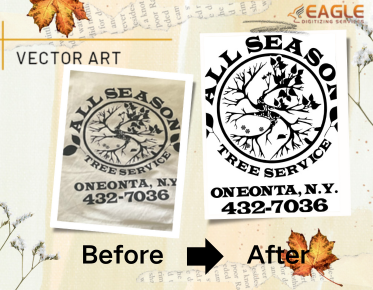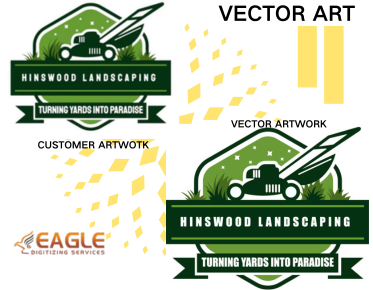Why Vector Graphics are Key to Cohesive Visual Branding
In today's visually driven digital landscape, maintaining brand consistency is key to building trust and recognition, and vector graphics are a powerful tool to achieve this. These scalable, adaptable designs enable brands to ensure uniformity across all platforms, from websites to social media, without losing quality or impact. By integrating vector graphics into a cohesive visual strategy, businesses can create striking, professional imagery that reinforces their identity and resonates with consumers. This article explores the importance of vector graphics in brand building, offering insights and best practices for creating a strong, consistent visual presence. If this post has aroused your curiosity about online vector artwork conversion and you hope to gain more knowledge, reach out to us without hesitation.
Brand Consistency and Recognition Through Vector Graphics
Brand consistency is a fundamental aspect of building trust and recognition among consumers. It ensures that no matter where or how people encounter your brand—whether on a website, social media, packaging, or advertising—the experience feels cohesive and familiar. This consistency creates a sense of reliability and professionalism, which fosters trust. One powerful tool for achieving this consistency is vector graphics.
Vector graphics allow for seamless scalability and adaptability without any loss of quality, making them ideal for maintaining uniformity across a wide range of platforms and mediums. Unlike raster images, which can become pixelated when resized, vector designs remain sharp and clear at any size, ensuring that logos, typography, and imagery always look polished and professional. Brands can confidently use the same elements on billboards, business cards, websites, and even mobile apps without worrying about discrepancies in appearance.
This flexibility makes vector graphics indispensable for reinforcing brand identity. A consistent visual presence helps consumers quickly recognize and recall a brand, which is crucial in crowded markets where attention spans are short. By using vector-based logos, icons, and other design elements across various touchpoints, brands create a unified and professional look that builds familiarity. Over time, this consistency strengthens brand recognition, making it easier for consumers to connect with your brand and feel confident in its reliability. In this way, vector graphics become a vital component of long-term brand success, fostering trust and recognition through seamless design.
Building a Cohesive Visual Identity on Social Media
Your brand’s social media presence is often the first point of contact for potential customers. Vectors allow you to create a cohesive, polished visual identity across all platforms. Whether it’s through custom icons, social media banners, or ad creatives, using vector graphics ensures your brand’s visuals are always sharp, professional, and aligned with your overall aesthetic. Consistency in design not only reinforces brand identity but also makes your content instantly recognizable in a crowded feed.
The Role of Color in Vector Graphics: Captivating Your Audience
Color is one of the most powerful tools in a designer’s arsenal, and vector graphics make it easier than ever to use color effectively. Vectors allow designers to experiment with bold, vibrant hues, gradients, and transparencies to create striking visual effects that capture attention and evoke emotion. With infinite scalability, colors remain vibrant regardless of size, giving you complete control over how your brand is perceived.
Harnessing the Power of Color Theory in Your Designs
Color theory plays a significant role in how audiences perceive your content. Understanding how different colors influence emotions and behaviors can help you create vector designs that resonate with your target audience. For example, blue is often associated with trust and calm, making it a popular choice for tech companies and financial institutions, while red conveys excitement and urgency, ideal for calls to action. Using the right colors in your vector graphics can subtly influence how your audience engages with your content.
How to Choose the Right Color Palette for Your Brand
Choosing the perfect color palette for your brand is more than just picking your favorite shades. It involves strategic thinking about your brand’s personality, target audience, and the emotional response you want to evoke. When creating vector graphics for social media, opt for a cohesive color palette that aligns with your brand’s message and appeals to your audience. This consistency will not only make your designs look professional but also strengthen brand recognition.
Vector Graphics in Action: Successful Case Studies
The power of vector graphics isn’t just theoretical—it’s proven in real-world success stories. Some of the most iconic brands use vector graphics to create memorable and engaging social media content. Whether it’s Nike’s clean, scalable logo or Airbnb’s dynamic illustrations, vectors have helped these brands establish a strong visual presence that resonates with their audience.
Brands That Excel with Vector Graphics
Nike, with its instantly recognizable Swoosh logo, is an excellent example of a brand that has mastered the use of vector graphics. Similarly, companies like Airbnb and Slack use vectors to create clean, approachable designs that communicate their brand values. By studying these brands, we can glean valuable insights into how vector graphics can be leveraged to build a consistent and engaging brand identity.
Learning from Their Success: Key Takeaways
The success of these brands teaches us that simplicity, scalability, and consistency are key when it comes to vector graphics. By focusing on clean, adaptable designs that work across multiple platforms, these companies have built visual identities that are instantly recognizable. For any brand looking to strengthen its social media presence, the takeaway is clear: vector graphics provide the foundation for visually compelling, cohesive content.
Best Practices for Creating Engaging Vector Graphics
When it comes to creating vector graphics for social media, there are a few best practices to keep in mind. Start with a simple design that can be easily scaled and adapted. Make sure your color palette is cohesive and aligns with your brand’s identity. Pay attention to typography, ensuring that fonts are readable and match your overall design. Finally, keep your audience in mind—design to spark engagement.
Tools and Software for Designing Vector Graphics
There are numerous tools available for creating stunning vector graphics. From Adobe Illustrator to free options like Inkscape, designers have a variety of software at their disposal. Each tool offers unique features, but the key is to choose one that suits your needs and allows for easy customization and scalability.
The Essential Tools Every Designer Should Use
Adobe Illustrator remains the industry standard for vector design, offering robust features for professionals. However, free alternatives like Inkscape and Vectornator are gaining popularity among those looking for accessible yet powerful design tools. Whether you’re a seasoned designer or a beginner, having the right tools can make all the difference in the quality of your work.
Tips for Beginners: How to Get Started with Vector Design
For beginners, starting with vector design may seem daunting, but it doesn’t have to be. Begin by familiarizing yourself with the basic tools in software like Illustrator or Inkscape. Practice creating simple shapes and designs before moving on to more complex illustrations. Don’t be afraid to experiment—vector design is all about trial and error. As you gain confidence, you’ll find that vector graphics open up a world of creative possibilities.
Measuring Success: Analyzing Engagement Metrics
Once your vector-based social media campaign is live, it’s essential to track its performance. Look at metrics like likes, shares, and comments to gauge how well your visuals are resonating with your audience. Engagement metrics will provide valuable insights into what’s working and what might need adjusting in future campaigns.
Understanding Your Audience’s Response to Visual Content
Beyond the numbers, it’s important to understand how your audience feels about your visuals. Pay attention to feedback—positive or negative—to refine your approach. If a particular design receives high engagement, take note of what made it successful. Likewise, if a post falls flat, consider what changes could be made to better connect with your audience.
Adjusting Your Strategy: What the Metrics Tell You
Metrics are more than just numbers—they tell a story. If your engagement is lower than expected, it could be a sign that your visual content needs tweaking. Perhaps the color palette isn’t resonating, or maybe the design is too complex for social media. Use your metrics to guide future designs and campaigns, constantly refining your approach to meet your audience’s needs.
The Future of Vector Graphics in Social Media
As social media continues to evolve, vector graphics are poised to play an even larger role. With trends leaning towards more interactive and dynamic content, vectors offer endless possibilities for animation, infographics, and 3D designs. The future of digital marketing will likely see a fusion of creativity and technology, with vector graphics leading the charge.
Emerging Trends: What’s Next for Vector Graphics?
We’re already seeing emerging trends like interactive vector graphics and responsive design taking shape. With advancements in technology, vector designs are becoming more dynamic, allowing for greater interaction and personalization on social media platforms. Expect more brands to leverage these trends to create immersive and engaging experiences for their audiences.
Final Thoughts: Embracing Vector Graphics for Maximum Impact
In a world where first impressions are everything, vector graphics provide a powerful tool for capturing and holding attention. Their scalability, versatility, and ability to create visually stunning designs make them a must-have in any digital marketing strategy. Brands that embrace vector graphics are not only enhancing their visual identity but also setting themselves up for long-term success in the ever-evolving world of social media. In case this post has sparked your enthusiasm for vector conversion services and you wish to know more details, please feel free to get in touch with us.
In conclusion, vector graphics are an indispensable asset for brands looking to maintain consistency and elevate their visual identity across multiple platforms. Their flexibility, scalability, and ability to produce crisp, high-quality designs ensure that your brand’s message is conveyed clearly, whether on social media, websites, or print. As trends in digital marketing continue to evolve, integrating vector graphics into your strategy not only strengthens brand recognition but also opens up endless possibilities for creative expression. By embracing vector design, you position your brand for long-term success and a lasting connection with your audience.



